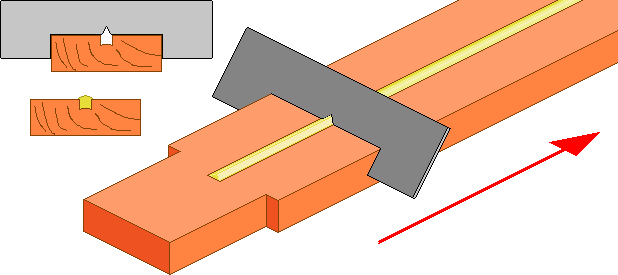Tolerances are + 0.1 mm. Material... Most softwoods are suitable, but all those that I manufactured at APEX Enterprises were made from hardwood.
The Stamfordham Top bar is supplied as a set of ten along with a 'normal' top bar that
will accept a sheet or triangle of foundation in order to get the bees
started on their job. The notches allow for castellated spacers, if they are used. Information
provided by Mike Lewis. As at 26-04-2018 Stamfordham did not appear to have a website. R.P.

Apex type 2B Top bar

In order to limit the number of places where wax moth could pupate, the central groove did not run to the ends, but finished at a point that was covered by a sidebar (if one was used). This type of bar was used for cut comb production as well as being used as a top bar in some special frames (cell bar frames, nursery cage frames, Etc.).
Apex type 2A Top bar

This 2A type was manufactured in two forms... The one shown here was used for cut comb production with beeswax melted into the central groove. The other type (future link) was without a groove and had drilled holes and was used to mount pairs of half width breeding frames for use in full sized brood boxes.
The bead of wax that was melted into the groove was shaped by dragging a scraper with a "V" ground in it so that the rounded surface of the still warm wax became formed into a triangular ridge. The dragging action caused crumbs of wax to form on the top of this inverted "V", the crumbs and the granular surface seem to attract attention from wax building bees much sooner than a smooth or unblemished surface.

This shaping increases the speed at which comb building starts. Because the ridge of the wax is much thinner and requires less effort for the bees to work on it with their jaws. Another reason that is only speculation on my part is that the surface of the wax from a poured bead is harder than the surface that has been shaped. The shaping action is a combination of machining off excess wax and displacing wax. However the percentage of these processes varies with the temperature at which the job is done... The warmer the wax the more the bead is forged rather than cut, resulting in a granular surface that also becomes lighter in colour.
I made my scraper from a portion of a large hacksaw blade that was intended for use in a power driven hacksaw. Tilting the scraper as shown in the diagram makes the job easier. The amount of wax deposited in the formation of the bead also governs the final shape of the pointed ridge and the roughness of the granular surface left as the blade is pulled along the bar.
If a small piece of foundation 50 mm wide by 8 mm tall is incorporated in the groove when the wax is poured, this speeds up comb drawing enormously as it acts as a focus of attention and starting point for many bees that can cluster both on it and around it and work on it initially, whereas if there is just a bead of wax only a small number are able to get close to the wax itself.
This idea has been taken further By Dennis Murrell , who has cast foundation less starters direct into the groove using a former made from moistened wood (so that the wax does not stick). I think this idea can be taken further still by casting wax starters that have ridges in the same pattern as the vertical portion of the cell walls of comb, which would provide more wax for re-modeling as well as providing a dimensional reference key for the cellsize of the finished comb. There is another aspect to this technique as the variation in cellsize across the width of a comb could be addressed by variable spacing in the starter strips.